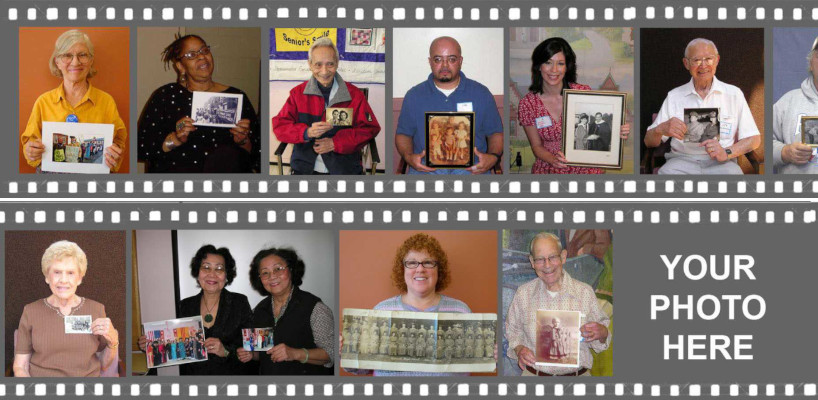Collecting information from Contributors about their Items adds value and context to the material and helps others to find and learn from them. At the Information Station, the second of three stations at your event, Contributors will share their stories about their Items.
Roles & Responsibilities
For an overview of all RoPA Roles and Responsibilities, please review the Building a Team module.
The Event Coordinator will make sure that the Information Station is equipped with the necessary supplies and paperwork, including the revised version of the Descriptive Information Form.
The Collection Coordinator will designate an Information Station Captain. The Collection Coordinator will work with the Information Station Captain and the Community Coordinator to revise the Descriptive Information Form to meet your project’s goals and to make sure the form captures all the necessary information that the Collection Working Group will need to put the collection online.
The Community Coordinator will work with the Collection Coordinator and Information Station Captain to modify the Descriptive Information Form as needed to meet the needs of the community.
Designated by the Collection Coordinator, the Information Station Captain will oversee all preparation, volunteer training, and day-of-event activities related to the Information Station. The Information Station Captain will be someone who is detail oriented and who is comfortable training volunteers and talking to new people.
The RoPA Developers recommend that the Information Station Captain be a library, museum, or cultural organization staff member who is familiar with personal narratives, oral history and/or descriptive metadata.
Depending on the size of your event, you will need eight to twelve volunteers for large events (100 people or more) or five to seven volunteers for smaller events (less than 100 people) to work one-on-one with each Contributor, helping them to select photos, complete and review Descriptive Information Forms. Individuals in this role should be good listeners, interested in hearing contributors’ stories, and able to ask questions to draw out additional details from Contributors. They also need to be detail-oriented to ensure the Descriptive Information Forms are complete and legible. It’s helpful if Information Station Volunteers are familiar with the community’s history and know how to handle old photographs.
Steps to Success
Download a Quick Checklist of the Describing Items steps here.
Best Practice Examples
Do you know of a project or program that could be featured here? Please contact us.
Resources
The Mass. Memories Road Show volunteer training modules on the Information Station (the basics) and (going deeper) describes in detail the program’s approach to the Descriptive Information Form and the philosophy behind it.
The University of California, Santa Cruz's Oral History Primer is a succinct overview of interviewing methods used to produce oral histories. The “Breaking the Ice” section of the primer provides tips that Information Station Volunteers may find useful in getting Contributors to open up and talk about their Items before completing a Descriptive Information Form.
The Queens Memory Project is an ongoing community archiving program supported by Queens Public Library and Queens College, CUNY in New York City. Queens Memory also provides training and materials for anyone wishing to contribute oral history interviews, photographs, or other records of their neighborhoods, families, and communities. These materials include suggested topics and interview questions.
Glossary
A set of information crafted to identify and represent an archival resource or component; the process of creating information representing an archival resource or component. (Adapted from Dictionary of Archives Terminology, Society of American Archivists.)
For RoPA, the second place that Contributors will visit at the event to share their stories about their Items. Information Station Volunteers will help Contributors choose their Items and complete a Descriptive Information Form for each Item being added to the collection. The Item section of the Item ID Number is assigned here.
Metadata is commonly defined as “data about data.” Metadata is frequently used to locate or manage information resources by abstracting or classifying those resources or by capturing information not inherent in the resource. Typically metadata is organized into distinct categories and relies on conventions to establish the values for each category. For example, administrative metadata may include the date and source of acquisition, disposal date, and disposal method. Descriptive metadata may include information about the content and form of the materials. Preservation metadata may record activities to protect or extend the life of the resource, such as reformatting. Structural metadata may indicate the interrelationships between discrete information resources, such as page numbers. (Adapted from Dictionary of Archives Terminology, Society of American Archivists.)
For RoPA, the unique process by which Items are assigned an unique Item ID Number at stations during the event. The Item ID Number consists of three parts: a pre-assigned event number, followed by the Contributor’s event registration or nametag number, followed by the number of the particular item that the Descriptive Information Form describes (1, 2, 3, etc.).
Originally set forth by historian Michael Frisch in an article about oral history several decades ago, sharing authority involves a consideration of perspectives of all stakeholders and collaborators, not just trained professionals. By incorporating the viewpoints of everyone with an interest in a subject--in addition to the expertise of scholars--we can create a more inclusive understanding of the past. (Adapted from Michael H. Frisch A Shared Authority: Essays on the Craft and Meaning of Oral and Public History. Albany: State University of New York Press, 1990.)


